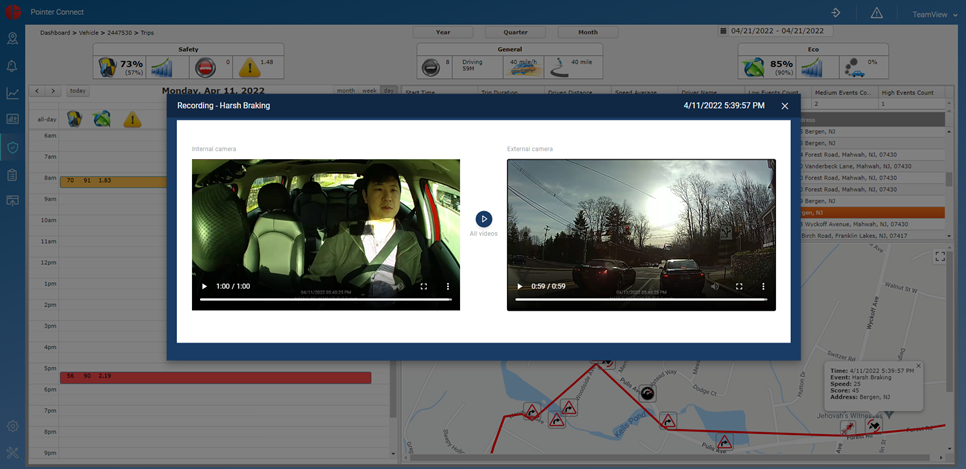The FMCSA reckons that there are more than 5,000 fatalities and over 100,000 injuries due to truck accidents each year. In addition to the human toll, the average large truck crash costs $91,000 per accident, with fatalities costing around $3.6 million. As a result, fleets must invest in high-quality fleet safety programs to minimize risk.
Most fleets appreciate the importance of hiring safe drivers, developing a robust training program, and adequately maintaining trucks and vehicles. However, the best fleet safety programs go beyond the basics to create a safety culture driven by data and supported with positive reinforcement that keeps everyone happy and motivated.
Let’s look at the three components of a great fleet safety program that go beyond the basics and how you can implement them in your fleet.
The best fleet safety programs create a culture of safety driven by data and supported by positive reinforcement. Compartir en X#1. Collect Data on Unsafe Driving Habits
Telematics arms you with the knowledge you need to make data-driven decisions. Tracking unsafe driving habits is one of the most important ways telematics technology improves fleet safety. Using telematics, fleet speeds, acceleration rates, and hard brakes can be monitored. The data can also be used to benchmark driver performance and assign drivers to safety training. For example, you can quickly calculate the number of on-the-road safety incidents over the past month and compare that figure to prior months. These trends can help you determine if overall fleet safety is improving or deteriorating, enabling you to take corrective action.
There are many types of data points to collect:
- Excessive speeding
- Harsh braking
- Sudden acceleration
- Abrupt cornering
- Excessive idling
- Lane departure warnings
- Collision warnings
The use of telematics also allows you to provide drivers with feedback and coaching in an unbiased and fair manner, so they are aware of what is expected of them and can maximize their performance.

PowerFleet aggregates telematics data, computes relevant KPIs and displays actionable information in a convenient web-based dashboard. In addition, PowerFleet Vista leverages live video feeds and artificial intelligence to provide real-time feedback to drivers, as well as capture and record conditions on the road or when parked if there’s a sudden jolt.
Telematics can also help fleets achieve better operational efficiency through real-time locations, environmental sensors, and other key data points, as well as better safety and compliance through door monitors and integrated ELD systems. As a result, most fleets can improve safety while simultaneously achieving a quick return on investment.
#2. Maintenance
Proper vehicle maintenance is key to safe operation. Monitoring vehicle engine data and maintaining truck engines and trailer parts proactive will minimize the chance of an on-the-road breakdown. A driver spot check should also be a requirement before driving. With modern ELD systems, truckers can not only ensure they’re not in violation of Hours-of-Service guidelines, but they can also ensure proper maintenance and avoid equipment malfunctions. PowerFleet’s ELD, for example, reduces compliance issues for drivers and continuously tracks engine hours. With its maintenance modules, it also plans ahead for PMs and prevents safety incidents on the road. The solution’s Vehicle Inspection Reports enhance fleet safety and prevent and help predict maintenance issues instead of reacting to them. Your maintenance team can even clear and save detailed messages as they clear items.
#3. Trip Optimization
One of the causes of accidents among major motor carriers is driver fatigue. An accident is more likely to happen if your drivers spend a lot of time on the road. Safe driving relies on efficient routing. Routing tools help drivers prepare for safety success passively, whereas scorecards and other reporting tools help drivers improve.
A truck movement analysis is essential, especially for repeat routes and continued deliveries, in order to improve efficiency. In order to avoid accidents-prone areas, alternative routes should be planned, existing routes should be streamlined to create a more direct route, and certain drivers and vehicles need to be prioritized along challenging or confusing routes.
In order to ensure your company is achieving the most efficient routes, you need telematics.
The Bottom Line
Effective fleet safety programs minimize the risk of accidents and fines while simultaneously maximizing performance. In addition to the proper hiring and training practices, you should seek to create a data-driven culture of safety that’s supported with positive reinforcement to keep everyone happy and motivated to improve over time.
If you’re looking to incorporate telematics data into your fleet, PowerFleet provides a broad range of solutions. Browse our products or contact us to learn more.






